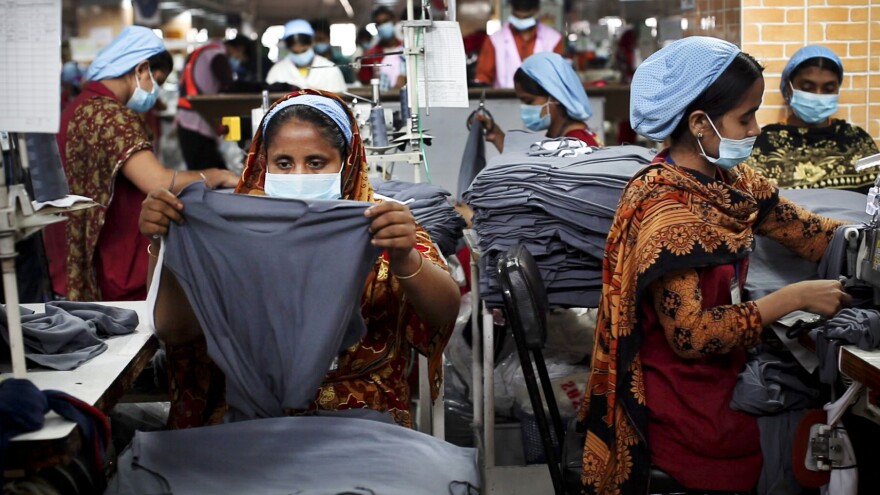More details were added to this post after it was published. The new information was courtesy of Vidiya Khan, director of the Desh Group, and daughter of Noorul Quader.
Bangladesh was created out of chaos in the early 1970s, at a moment when millions in the country were dying from a combination of war and famine. The future looked exceedingly bleak.
Abdul Majid Chowdhury and Noorul Quader were Bangladeshi businessmen who wanted to help their country. "We asked ourselves, 'What the hell do we want?' " Chowdhury recalls. The answer he and his friends arrived at: "We need employment. We need dollars."
Their solution involved Richard Nixon, an obscure but hugely influential trade deal, and a cultural struggle over kimchi.
At the time, Bangladesh had no modern economy to speak of. The country's main export was jute, a fiber used to make burlap sacks. So Quader and Chowdhury looked to textiles, an industry that had been a first step out of rural poverty for dozens of countries, stretching all the way back to the Industrial Revolution in England. One problem: Chowdhury didn't know the first thing about the textile business. "I did not know how many buttons I had in my shirt," he says.
A few decades earlier, South Korea had also been a largely rural country that was devastated by war and written off by much of the world. But, partly by learning to make clothes and sell them to the world, South Korea had climbed the ladder out of poverty.
Quader and the head of a major garment factory in South Korea had been in touch about the possibility of manufacturing in Bangladesh. So Quader sent Chowdhury to South Korea, where he toured a clothing factory full of women working at sewing machines. He knew instantly that women in Bangladesh could do the work.
Chowdhury sat down for a meeting with the head of Daewoo, the giant company that owned the factory. They talked to the guy for ten hours, until 2 in the morning. The meeting worked. Daewoo agreed to invest in a clothing factory in Bangladesh.
Help came from an unlikely source: President Richard Nixon. In the early '70s, clothes and textiles were pouring into the U.S. from South Korea and other countries and were threatening U.S. textile jobs. European countries were having the same problem. In response, Nixon worked with European leaders to create a global agreement called the Multi-Fiber Arrangement. The boring-sounding deal reshaped much of the global economy.
The MFA set firm quotas for how much clothing other countries could sell to the United States and European countries. The rules were incredibly detailed: Sri Lanka can sell only so many bras to the U.S. each year; China can sell this many T-shirts, and no more.

And, crucially, around the time Chowdhury made his trip to the Daewoo clothing factory, South Korea had hit its quota under the MFA. That gave Korean companies an incentive to set up shop somewhere else — like, say, Bangladesh — to be able to make clothes for export to the U.S.
Quader, with Chowdhury's help, wound up bringing a group of 128 of his countrymen to train with Daewoo in South Korea for six months. The culture clash was instant. "The problem we had was the stinky food — the kimchi," says Muhammad Nuruddin, one of the trainees, who still works in garments today. "We could not eat them ... Some girls were vomiting."
The Koreans were similarly weirded out by the Bangladeshis. It was the first time Kim Eun Hee, a trainer at Daewoo in charge of the collar-and-cuff section, had ever met someone from that part of the world. "When they were around, there were these different spices that I could smell from them," he recalls. "It was not too easy at first to approach them and to be near them."
But they worked through it. Kim Eun Hee even tried Bangladeshi food himself. "Once, they invited us to a special event that they prepared for us," he says. "They served some of their food to us, and we couldn't eat it. It was just repelling."
It was so awkward, that the boss had to intervene. "Our CEO actually called all of us out," Kim says. "He brought us to a corner room and said, 'We're going to be living in an international society, and this is something we're going to have to endure. So suck it up and just eat it.' "
The CEO was right: In 1980, Kim Eun Hee flew to Bangladesh to help set up the country's first export-oriented garment factory, Desh Garments, led by Noorul Quader, the Chairman and Managing Director. Quader hired Chowdhury to work with him as a director.
In the 30 years since then, Bangladesh has become one of the world's largest exporters of apparel. This has created millions of jobs and helped drive down the country's poverty rate, but the rapid change has also created new problems for Bangladesh. This was made tragically clear earlier this year, when the Rana Plaza factory building collapsed, killing more than 1,000 workers.
Today, there are more than 4,000 garment factories in Bangladesh. One way or another, most of them trace their lineage to Quader, Chowdhury and the 128 Bangladeshis who traveled to Korea 30 years ago.
Copyright 2021 NPR. To see more, visit https://www.npr.org.



